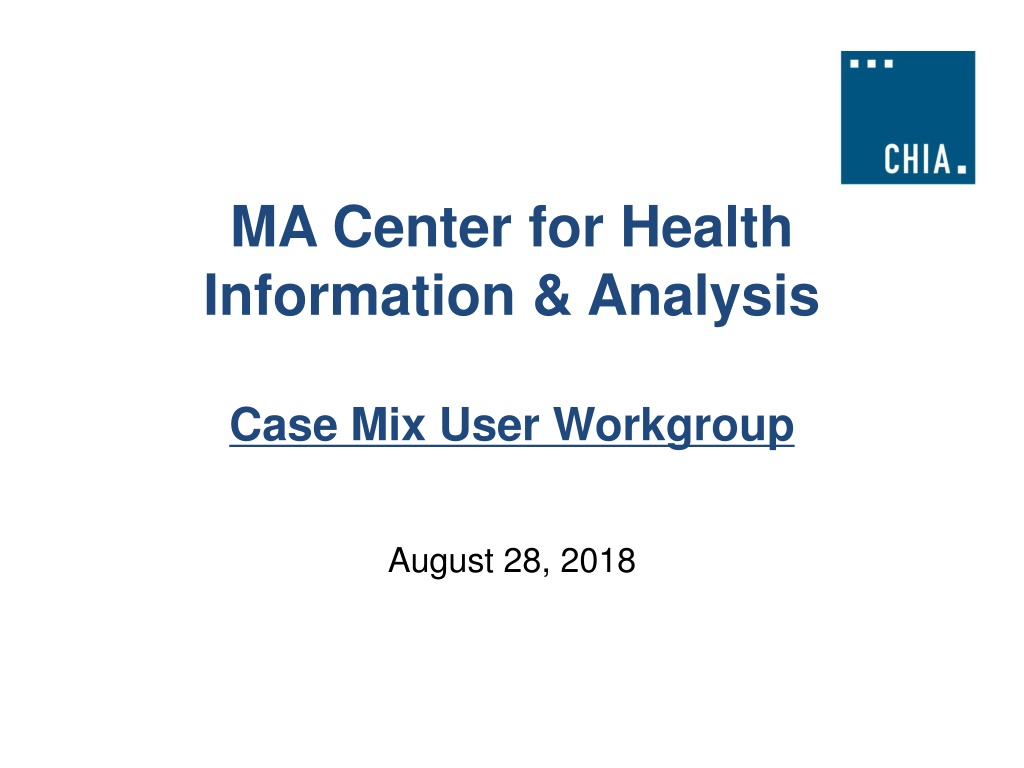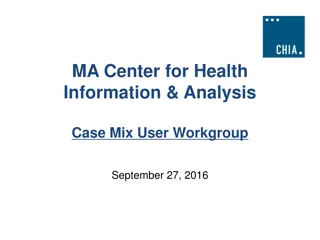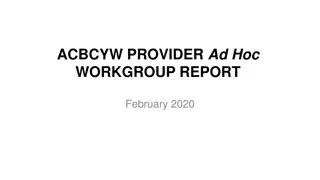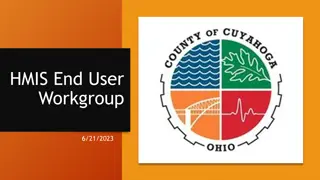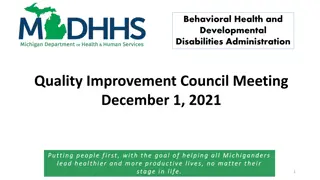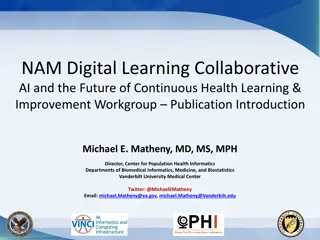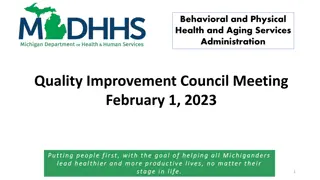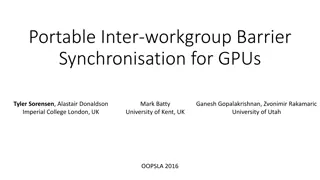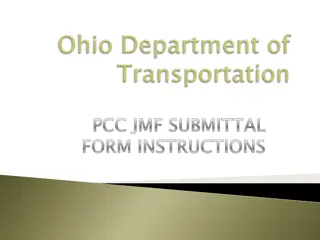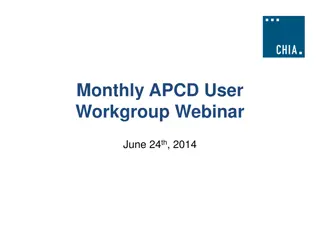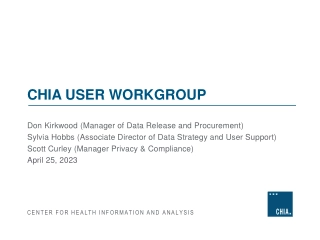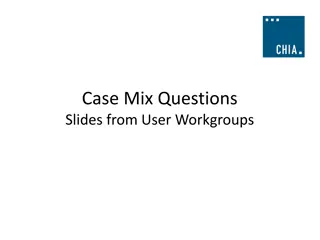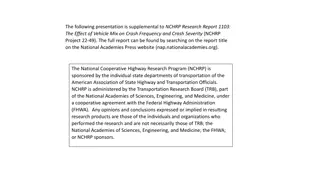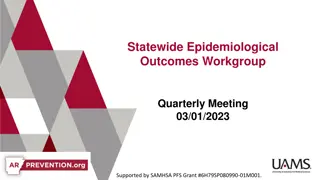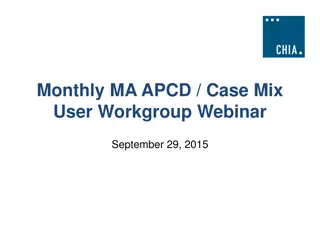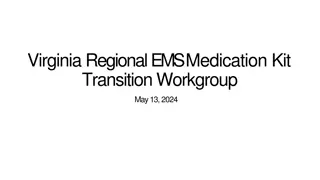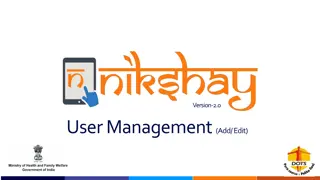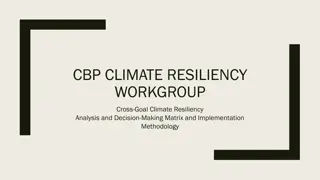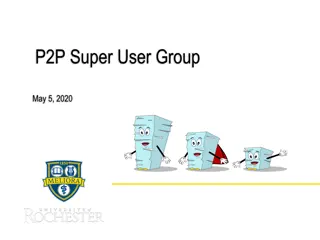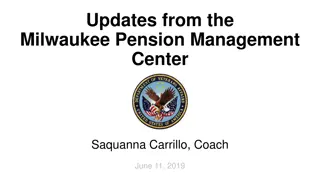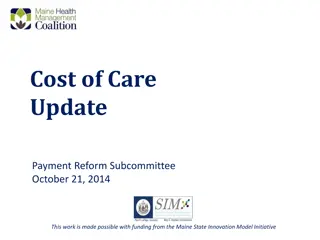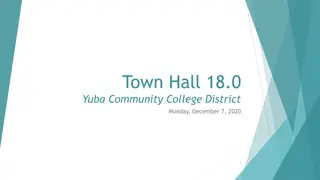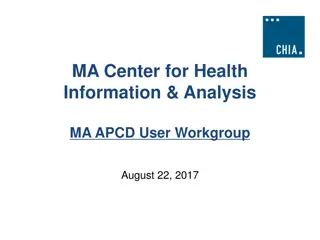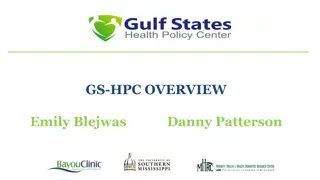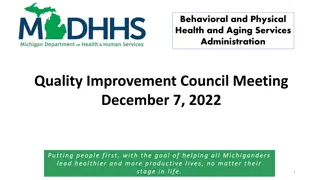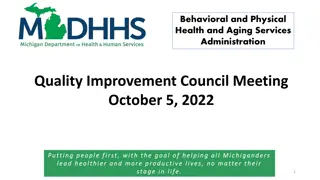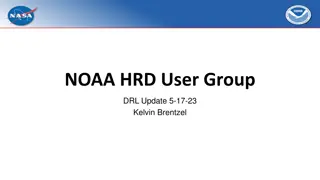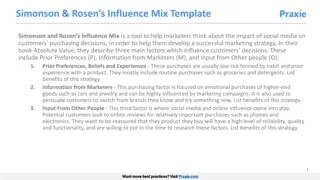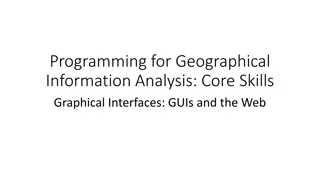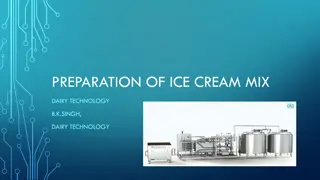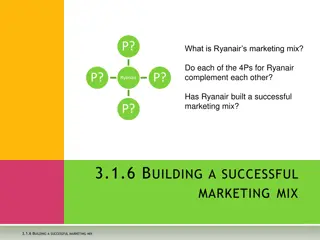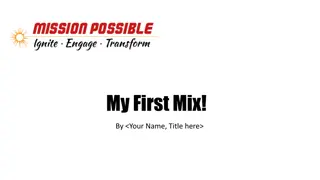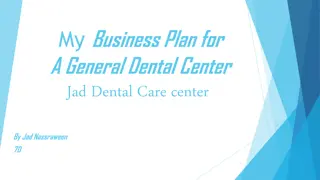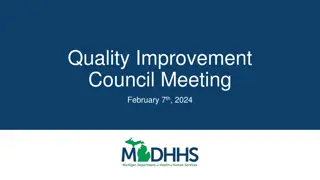MA Center for Health Information & Analysis Case Mix User Workgroup Updates
Center for Health Information & Analysis provides updates on the FY17 Case Mix Data Release, including information on patient disposition in outpatient emergency departments, ICU utilization changes, and release timeframes for various data files. The updates cover repeat and new applicants, resubmitted data for missing discharges, and upcoming changes to prior releases.
Download Presentation

Please find below an Image/Link to download the presentation.
The content on the website is provided AS IS for your information and personal use only. It may not be sold, licensed, or shared on other websites without obtaining consent from the author. Download presentation by click this link. If you encounter any issues during the download, it is possible that the publisher has removed the file from their server.
E N D
Presentation Transcript
MA Center for Health Information & Analysis Case Mix User Workgroup August 28, 2018
Agenda Announcements Updates on FY17 Case Mix Data Release Updates to Prior Releases (FY2015-2017) Additional Info on Summarized Data Reports User Questions: Patient Disposition in Outpatient Emergency Department (ED) Data Changes in ICU Utilization Website Updates Q&A
Case Mix FY17 Release Calendar *CURRENT* RELEASE TIMEFRAMES FOR EACH FILE: Inpatient (HIDD) JUNE [Completed] Emergency Department (ED) SEPTEMBER Outpatient Observation (OOD) OCTOBER
Case Mix FY17 Data Release REPEAT APPLICANTS For those applicants with previously approved projects who indicated they would like to receive data annually, we began accepting Certificates of Continued Need and Compliance (Exhibit B of your DUA) starting on May 1st. After receiving this, we will send you an invoice for the FY17 data and release data to you once payment is received and the data is ready If you are making any changes to your project, you must go through the amendment process first
Case Mix FY17 Data Release NEW APPLICANTS / NEW PROJECTS We will continue to accept new applications on a rolling basis. If you are requesting FY17 data, just click the box for Subscription on p. 3 of the application form:
Updates to Prior Releases FY2015 - One hospital has resubmitted data due to approximately 3400 missing birth discharges. FY2016 Two hospitals resubmitted data to include approximately 700 missing behavioral health inpatient discharges. FY2017 (A) One hospital had a data conversion issue, where Zip Code was reported as 00000 for approximately 5400 discharges. The data was resubmitted; (B) An anomaly was discovered in the Payer Source Code and Payer Type Code data where values were erroneously removed from the released data. This is being corrected.
Updates to Prior Releases Further details will be provided here as we update each Release. Changes will be documented in the Case Mix Release documentation (can be found on the Case Mix website) FY2017 will be updated first and is expected to be ready in September. We will likely reach out to affected users to see if they would like an updated data extract.
Summarized Data Reports CHIA has updated our Data Release Regulations to allow for Summarized Data Reports Will contain only aggregate data (data summaries) and De- identified Data, sourced from MA APCD and Case Mix data Examples of Summarized Data Reports include: counts; totals; rates per thousand; index values; and other standardized metrics. Will be subject to CHIA s cell suppression policy (no cell less than 11 will be displayed) Request form can be found on the MA APCD Application Documents page: http://www.chiamass.gov/application- documents
Summarized Data Reports In determining whether to compile such a report, CHIA will consider the public interest served, the availability of its resources, the complexity of the request, and privacy concerns (i.e. that there is no more than a minimal risk to individual privacy in the public release of the report) Submit the request via the new form please provide as much information as you can, including mock-ups of what you expect the reports to look like o Data Use Agreement and Data Management Plan not required The Executive Director (or his/her designee) will approve or deny such requests. Such approval/denial is final and not subject to further review or appeal. A support/production fee of $140/hour will be charged
What goes into creating a report? Summarized Data Reports take, on average, 10 hours of CHIA resource time to complete. Steps include: 1) Initial review to determine feasibility and spot potential issues 2) Additional review and revisions with applicant to determine final specifications 3) Final review and Approval to proceed with the report request 4) Create documentation, including code, on steps to complete request 5) Independent code review and QA of results 6) Create documentation for the recipient 7) Produce final cut of data / report results
Question: I have a question about patient disposition in the FY2016 Outpatient Emergency Department data. The value for code 6 (eloped) has a frequency of 2% which seems high; it is higher than code 4 (against medical advice). Can you confirm that this is expected or provide any insight? Answer: The volume of patients who elope from the ED has always been been higher than the volume of patients who leave against medical advice (See Table 1 below). In evaluating year-to-year fluctuations in the frequency of patients who elope, 2% is not a wild variance from the 10-year median of 1.9% (See Table 2 below). Over the past 10 years, there have been three instances where the year-to-year percent increase in the frequency of elopes exceeded the percent increase seen from FY2015 to FY2016. The Joint Commission defines elopement as, When a patient wanders away, walks away, runs away, escapes, or otherwise leaves the hospital unsupervised, unnoticed, and/or prior to their scheduled discharge . The FY2016 increase is mainly attributable to an increase in patients ages 20 to 30 with unspecified pain who elope. Table 1: Ten-Year Comparison of Massachusetts Outpatient ED Visit Volume by Departure Status Departure Status (Code) Blank/Invalid Died during ED Visit (0) Routine (1) Transferred to another facility (3) Against Medical Advice (4) Eloped (6) Within Hospital Clinic Referral (8) Dead on Arrival (9) Met with Personal Physician( P) 2007 2008 2009 2010 2011 2012 2013 2014 2015 2016 197 7,746 244 250 4,467 172 4,311 228 4,283 163 4,970 258 5,057 170 5,995 97 92 4,398 5,490 4,626 2,295,575 89,116 25,155 46,864 2,572 2,315,335 96,554 26,067 52,266 2,629 2,340,666 96,955 24,514 47,320 3,164 2,329,370 100,025 22,670 47,534 3,821 2,314,423 103,304 22,635 48,974 3,439 2,355,704 106,757 24,122 42,027 1,744 2,331,584 112,882 24,865 44,919 1,539 2,276,715 116,532 27,018 42,689 1,414 2,283,450 108,612 24,553 49,694 1,355 2,316,438 108,601 23,918 52,735 1,020 394 1,676 498 363 2,934 375 1,410 392 1,308 374 2,922 508 258 458 204 551 152 887 97 2,078 TOTAL ED VISIT VOLUME Table 2: Ten-Year Comparison of Massachusetts Outpatient ED Visit Frequency by Departure Status 2,469,295 2,500,069 2,520,633 2,509,688 2,498,986 2,538,783 2,521,870 2,471,195 2,473,954 2,508,414 Departure Status (Code) Blank/Invalid Died during ED Visit (0) Routine (1) Transferred to another facility (3) Against Medical Advice (4) Eloped (6) Within Hospital Clinic Referral (8) Dead on Arrival (9) Met with Personal Physician( P) 2007 0.01% 0.31% 92.96% 3.61% 1.02% 1.90% 0.10% 0.02% 0.07% 2008 0.01% 0.18% 92.61% 3.86% 1.04% 2.09% 0.11% 0.02% 0.08% 2009 0.01% 0.18% 92.86% 3.85% 0.97% 1.88% 0.13% 0.01% 0.12% 2010 0.01% 0.17% 92.82% 3.99% 0.90% 1.89% 0.15% 0.01% 0.06% 2011 0.01% 0.17% 92.61% 4.13% 0.91% 1.96% 0.14% 0.02% 0.05% 2012 0.01% 0.20% 92.79% 4.21% 0.95% 1.66% 0.07% 0.01% 0.12% 2013 0.01% 0.20% 92.45% 4.48% 0.99% 1.78% 0.06% 0.02% 0.01% 2014 0.01% 0.24% 92.13% 4.72% 1.09% 1.73% 0.06% 0.02% 0.01% 2015 0.00% 0.22% 92.30% 4.39% 0.99% 2.01% 0.05% 0.02% 0.01% 2016 0.00% 0.18% 92.35% 4.33% 0.95% 2.10% 0.04% 0.04% 0.00%
Question: I am studying changes in ICU utilization and costs and see that, even though inpatient hospitalizations are trending downward, ICU utilization is trending upward. Can you confirm that this is true and provide any insight? Answer: Yes, while inpatient discharges trended downward, patients requiring ICU services have incrementally been trending upward (see Figures 1 and 2 below). The increases are not across all types of ICU services but the days of services and number of patients requiring those services are higher for intermediate ICU and other intensive care (See Table 3 below). Fig 1. FY2009 to FY2017 Total Discharges by ICU and Non-ICU Use Fig 2. FY2009 to FY2017 Percent Discharges by ICU and Non-ICU Use Non-ICU ICU Non-ICU ICU 100% 900,000 87.70% 87.50% 87.00% 86.90% 86.40% 825,000 86.10% 86.00% 85.50% 85.20% 90% Total Inpatient Discharges 750,000 80% 675,000 70% 600,000 60% 525,000 50% 450,000 375,000 40% 300,000 30% 225,000 20% 14.80% 14.50% 14.00% 13.90% 13.60% 13.10% 13.00% 12.50% 12.30% 150,000 10% 75,000 0% 0 FY2009 FY2010 FY2011 FY2012 FY2013 FY2014 FY2015 FY2016 FY2017 FY2009 FY2010 FY2011 FY2012 FY2013 FY2014 FY2015 FY2016 FY2017 Table 3. FY2009 to FY2017 ICU Days of Service by ICU Service Type (Note: Asterix (*) for cell suppression for number of days can be used to impute a patient volume less than 11) 2009 293,097 * * 9,204 3,980 125,042 4,233 3,555 2010 290,031 * * 9,404 4,133 131,933 3,576 3,405 2011 286,971 * * 8,688 3,885 137,678 4,645 3,524 2012 278,458 * * 8,325 4,118 131,866 4,442 3,287 2013 289,256 * 276 6,851 4,023 158,668 5,001 3,301 2014 290,043 * 260 7,113 3,710 165,852 3,962 3,484 2015 283,360 * * 7,371 3,832 147,078 4,100 5,587 2016 278,851 * * 7,888 4,073 155,050 3,911 6,863 2017 280,534 * * 7,403 3,793 164,421 3,154 5,500 Revenue Code Description 0200 INTENSIVE CARE UNIT-GENERAL CLASSIFICATION 0201 INTENSIVE CARE UNIT-SURGICAL 0202 INTENSIVE CARE UNIT-MEDICAL 0203 INTENSIVE CARE UNIT-PEDIATRIC 0204 INTENSIVE CARE UNIT-PSYCHIATRIC 0206 INTENSIVE CARE UNIT-INTERMEDIATE ICU 0207 INTENSIVE CARE UNIT-BURNCARE 0209 INTENSIVE CARE UNIT-OTHER INTENSIVE CARE
Question (continued): I am studying changes in ICU utilization and costs and see that, even though inpatient hospitalizations are trending downward, ICU utilization is trending upward. Can you confirm that this is true and provide any insight? Answer(continued): Please keep in mind that, unlike the MA APCD, the only currency information contained in Case Mix data is charges not costs. However, in FY2015, the limit was lifted on the number of diagnosis codes that can be submitted in Case Mix, which allows the researcher to have a larger depth of data for comorbidity analysis on patients requiring ICU services. For example, in Table 4 below, you will see that the increase in patients requiring intermediate ICU services was paralleled by an increase in the number of recorded comorbid diagnosis. Table 4. FY2009 to FY2017 Patient Volume by Type of ICU Services and Number of Diagnosis Codes Number of Diagnosis Codes Revenue Code Description 2009 2010 2011 2012 2013 2014 2015 2016 2017 INTENSIVE CARE UNIT - GENERAL CLASSIFICATION INTENSIVE CARE UNIT - GENERAL CLASSIFICATION INTENSIVE CARE UNIT - GENERAL CLASSIFICATION INTENSIVE CARE UNIT - SURGICAL INTENSIVE CARE UNIT - MEDICAL INTENSIVE CARE UNIT - PEDIATRIC INTENSIVE CARE UNIT - PEDIATRIC INTENSIVE CARE UNIT - PSYCHIATRIC INTENSIVE CARE UNIT - PSYCHIATRIC INTENSIVE CARE UNIT - PSYCHIATRIC INTENSIVE CARE UNIT - INTERMEDIATE ICU INTENSIVE CARE UNIT - INTERMEDIATE ICU INTENSIVE CARE UNIT - INTERMEDIATE ICU INTENSIVE CARE UNIT - BURN CARE INTENSIVE CARE UNIT - BURN CARE INTENSIVE CARE UNIT - BURN CARE INTENSIVE CARE UNIT - OTHER INTENSIVE CARE INTENSIVE CARE UNIT - OTHER INTENSIVE CARE INTENSIVE CARE UNIT - OTHER INTENSIVE CARE 0200 less than 16 76814 76308 76466 75824 75670 74432 28407 29380 26244 0200 16 to 44 45357 44771 48404 0200 0201 0202 0203 0203 0204 0204 0204 0206 0206 0206 0207 0207 0207 0209 0209 0209 45 and greater less than 16 less than 16 less than 16 16 to 44 less than 16 16 to 44 45 and greater less than 16 16 to 44 45 and greater less than 16 16 to 44 45 and greater less than 16 16 to 44 45 and greater 594 * * 1922 283 125 452 * 18503 21365 105 381 419 * 133 170 * 504 * * 1874 273 232 400 * 22059 23260 96 287 461 * 190 181 * 800 * * 1798 375 380 240 * 21839 25537 139 222 498 * 164 86 * * * * * * * * * * * 146 2345 138 2289 2634 2780 2720 2518 491 518 588 635 546 567 30175 32085 36902 35843 37408 38352 676 650 921 870 878 854 196 202 205 202 222 241
Where can I find old User Workgroup presentations? http://www.chiamass.gov/ma-apcd-and-case-mix-user-workgroup-information/
NEW! Updates to the User Workgroup Webpage User Support slides and tutorials are now available to view and download separately from the presentations. We will continue to update this page as new presentations happen from month to month. Link: http://www.chiamass.gov/ma- apcd-and-case-mix-user-workgroup- information/
Updated Case Mix White Paper Our white paper containing an updated overview of the Case Mix data base was posted last June. Available on the Case Mix website or via this link: http://www.chiamass.gov/assets/U ploads/casemix/Case-Mix- Whitepaper.pdf
Questions? Questions related to APCD : (apcd.data@state.ma.us) Questions related to Case Mix: (casemix.data@state.ma.us) REMINDER: Please include your IRBNet ID#, if you currently have a project using CHIA data
Call for Topics and Presenters If there is a TOPIC that you would like to see discussed at an MA APCD or Case Mix workgroup, contact Adam Tapply [adam.tapply@state.ma.us] If you are interested in PRESENTING at an MA APCD or Case Mix workgroup, contact Adam Tapply [adam.tapply@state.ma.us] You can present remotely from your own office, or in-person at CHIA.
